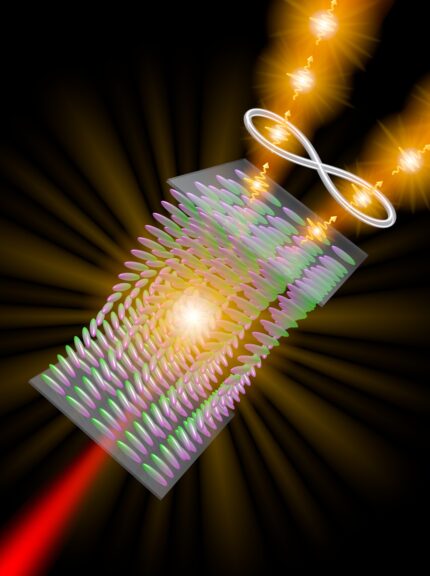Spontaneous parametric down-conversion (SPDC) – the splitting of a single photon in two – is crucial for photonic quantum technologies. In its very essence, SPDC breaks the inversion symmetry. It is therefore only possible in non-centrosymmetric crystals but not in isotropic materials like ordinary liquids or gases.
Recently, however, ferroelectric nematic liquid crystals have been discovered, whose molecules are elongated and asymmetric. Neighboring molecules form ferroelectric domains with spontaneous polarization. Importantly, they can be re-oriented by external electric fields.
The group of Maria Chekhova has implemented SPDC, for the first time, in such a liquid crystal. The efficiency is as high as in the best nonlinear crystals, such as lithium niobate, of similar thickness. By applying an electric field of just a few Volts, they were able to switch the generation of photon pairs on and off, as well as to change the polarization properties of these pairs. This discovery starts a new generation of quantum light sources: flexible, tunable, and efficient.
For more information, see their publication in Nature:
Tunable entangled photon-pair generation in a liquid crystal
Sultanov, V., Kavčič, A., Kokkinakis, E. et al.
Nature 631, 294–299 (2024)
(Picture by Aljaž Kavcic)

Spontaneous parametric down-conversion (SPDC) – the splitting of a single photon in two – is crucial for photonic quantum technologies. In its very essence, SPDC breaks the inversion symmetry. It is therefore only possible in non-centrosymmetric crystals but not in isotropic materials like ordinary liquids or gases.
Recently, however, ferroelectric nematic liquid crystals have been discovered, whose molecules are elongated and asymmetric. Neighboring molecules form ferroelectric domains with spontaneous polarization. Importantly, they can be re-oriented by external electric fields.
The group of Maria Chekhova has implemented SPDC, for the first time, in such a liquid crystal. The efficiency is as high as in the best nonlinear crystals, such as lithium niobate, of similar thickness. By applying an electric field of just a few Volts, they were able to switch the generation of photon pairs on and off, as well as to change the polarization properties of these pairs. This discovery starts a new generation of quantum light sources: flexible, tunable, and efficient.
For more information, see their publication in Nature:
Tunable entangled photon-pair generation in a liquid crystal
Sultanov, V., Kavčič, A., Kokkinakis, E. et al.
Nature 631, 294–299 (2024)
(Picture by Aljaž Kavcic)